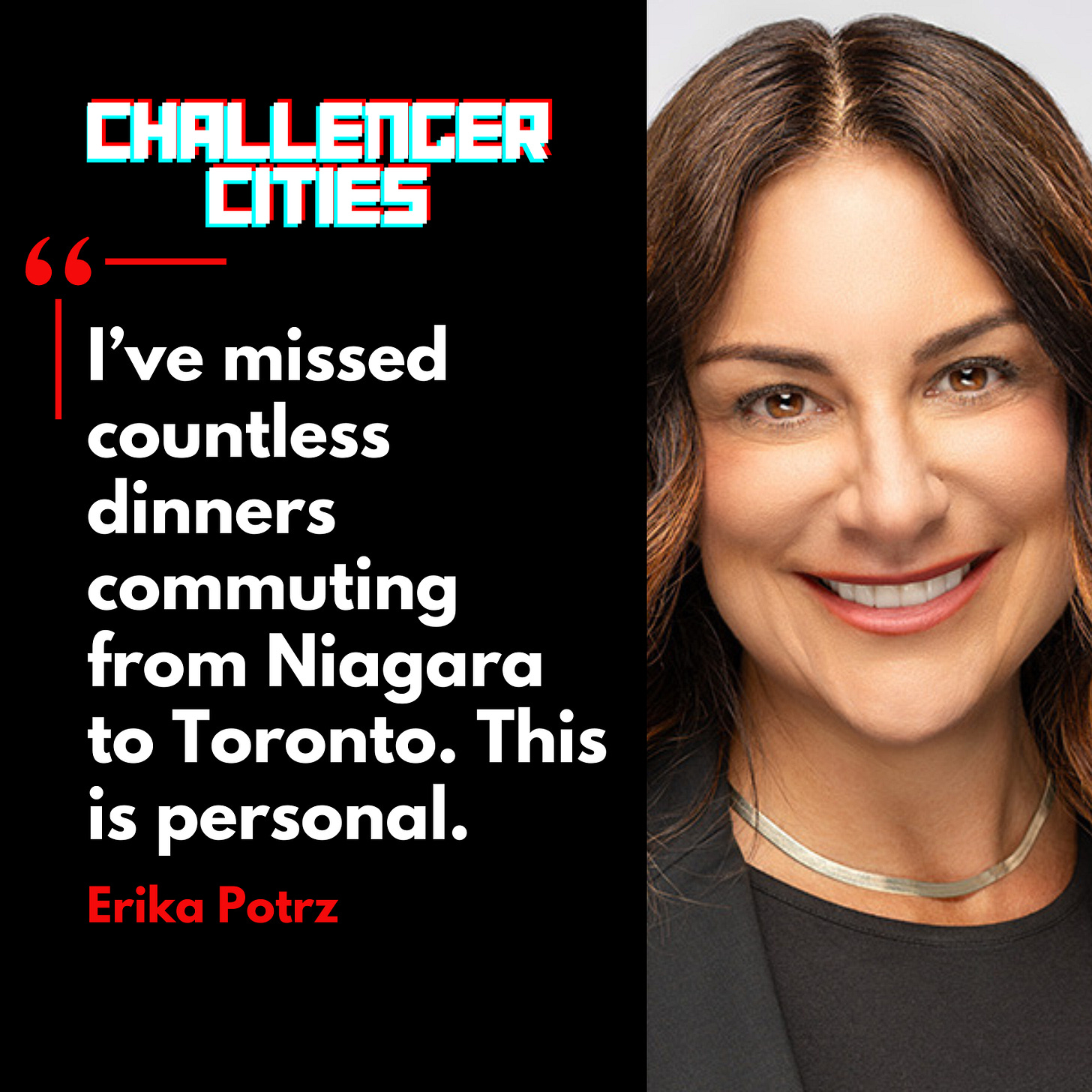Most attempts to fix Ontario’s transport mess tend to fall into two buckets; either keep building more highways, or eventually, the GO train will be electric and run all day. The former assumes everyone will keep driving forever, and there will be infinite ability to keep adding new lanes. The other promises that one day, there will be a proper European style rail system, though they just got rid of Deutsche Bahn so who knows when the vision will be realised!
But what if there was a third option, one that doesn’t follow any tracks, require huge amounts of new roads or sit in traffic at all?
That’s exactly what Erika Potrz is betting on. She’s a former pediatric cardiac nurse turned pharmaceutical exec turned hovercraft entrepreneur. I like the unconventional types on this thing, and we’ve had maybe a couple more classical urbanists on here lately. Erika might not necessarily be the kind of person you expect to find reshaping Ontario’s transport map, but maybe that’s why she might succeed.
What started as a favour for a friend as a small consulting ask turned into a full-blown commitment to building Hoverlink: a high-speed, military-grade hovercraft service connecting the Niagara Region and Toronto, across Lake Ontario in just 30 minutes. With permits done, land secured, terminals in progress and a real shot at closing the funding required this year.
Now I’m told there’s been some attempts at better utilising the lake for ferry services before, though perhaps they’ve been thwarted by the likes of ice. Well hovercraft might not have the same issue of ferries or hydrofoils here. They skim a metre above water and don’t blink at ice, swell or wind. Their kind are used by coast guards and militaries, now reimagined for commuters, tourists, students, hockey fans and wine drinkers.
There’s something refreshing about how Erika talks about transport, for she’s not a policy wonk, nor does she entirely nerd out on the engineering. She talks a lot more about the experience of what the Hoverlink service will feel like, and articulates in the benefits like giving people their time back. “I’ve missed countless dinners commuting from Niagara to Toronto,” she says. “This is personal.”
Hoverlink won’t solve everything, in fact, the whole thing about mobility is that it requires a mix. It’s not pretending to be mass transit, though 24 round trip journeys a day with a couple hundred people on each craft will make a sizeable dent in the traffic. It’s also looking to solve a very functional issue, that gets very emotional, by leaning into the idea that riding a hovercraft should be fun too!
The Joy of Movement
We’ve sterilised travel, especially in North America. The goal is always to squeeze more people into tighter spaces with less experience because that's what makes the financial model work. Hoverlink sorta says screw that, for there’ll be bathrooms, Wi-Fi, DJs on board for Friday night trips, a bar in the Niagara terminal. Maybe even guided audio tours on the way across.
“We want people to feel like a kid again,” Erika says. “There was a time when getting on a plane was exciting. We want to bring that excitement back.” And she’s right. Because the moment you add joy to transit, you stop viewing it as a utility and start treating it as part of the experience. You might even choose it, not because it’s faster (though it will be), or cheaper (will probably be), but because it’s better.
Which, if we’re honest, is where much public transport fails. It might be good enough on paper, but it doesn’t elicit any emotion.
Practical Magic
Let’s be clear, Hoverlink isn’t cheap, for the craft themselves are expensive and the terminal require investment to build. But as Erika points out, so does everything else. “We’re spending billions on highways and GO stations that are publicly funded and cost more to maintain than people realise,” she says. “Hoverlink costs a fraction, and we’re trying to make it privately.”
In theory, there should be a strong bond between the Niagara Region and Toronto, but in reality, there’s not. If you’re reading this from Toronto, hand on heart, how often do you get down there? And when you do, how much time do you spend sitting in the car.
So why do we make delivering ambitious (though really, rather doable) projects like this so hard in Canada? Especially when congestion is chronic, climate change is real, and now there’s an added economic threat from the neighbours across the lake and river.
Erika has had to spend years fighting bad assumptions on this project, from all sorts of people who themselves have to sit in traffic and navigate the frequent accidents on the QEW and Gardiner Expressways. These include the idea that hovercraft are noisy. (They're not, roughly 67 decibels, so less than background noise in most cities.) Or that they can't handle ice. (They’re used in the Aleutians and Arctic for that exact reason.) Or that Toronto as the city of ‘no’ will stand in the way. I’m told financing has been challenging, for this is a novel thing when it comes to passenger transport in Canada, though Hoverlink are 60% of the way through finding the funds.
Smartly, Erika also ties transportation to housing. “The median house price in St. Catharines is $600,000,” she says. “That’s half of Toronto. What if we gave people the option to live in a real home with a backyard, and still be in downtown Toronto in 30 minutes?”
Hoverlink has the potential to make commutes humane for people going one way, while making tourism far more attractive going the other. Anyone who’s been to Niagara on one of those shuttles, or had friends do it, knows how painful it can be (literally), sitting in traffic having had a couple, or more, glasses of wine!
Building Behavioural Bridges
Hoverlink’s true potential lies not just in the transport itself, but in the psychology of mobility beyond the car. It’s easy to say we want greener or more efficient systems, but we still default to cars because they offer a sense of control, comfort and choice.
Hovercraft offer a different behavioural gateway, because, well, they’re cool! They let our our inner 5 year old that gets excited riding on a new type of vehicle, plus they’re fun to watch too! For the 55 year old, they let you drink wine sitting in a lovely vineyard knowing it’s ok to have another glass. While for the 35 year old, young parent, building a corporate career, they can clear the emails and not worry about being stuck in traffic when it’s approaching the little one’s bedtime or after school activity.
Erika’s betting that fun is what makes people change behaviour, not guilt or obligation. But, all the way back to episode 14 where we talked about joy!
“People say: but has it been done here before? No. But it's been done elsewhere. And besides, we’ve never needed it more than now, ” Erika explains. One of those ‘elsewheres’ is the Isle of Wight, home to one of the world’s longest-running hovercraft services. Erika took a group of Canadian politicians there to experience it firsthand. They came off the craft beaming, saying they felt like kids again. One MP literally said, “That was such a cool experience.”
It matters in North America, because transport that works and makes you smile is vanishingly rare. In that moment, they didn’t need a presentation to be convinced, but instead a was pure, visceral proof that this isn’t some wild sci-fi fantasy. It’s can be real, it is fun, and it probably will work.
The Bigger Picture
When asked what she'd do with a magic wand, Erika didn’t wish for faster permits or more subsidies. She wished for more innovative thinkers, shifting the ~2% of people comfortable with change and risk into something closer to ~50%. Less cynicism, more possibility.
But Erika’s imagination didn’t stop there. She talks about transit-oriented communities not as something reserved for dense urban cores, but as something that could, and should, exist along the lake. “What if developers sold hovercraft commuter passes instead of parking spots?” she asks. “What if a condo came with a transit link, not just a place to put your car?”
Or what if, like cycle-to-work schemes in Europe, companies started offering hovercraft passes as an employee benefit? Flipping the script on what a better commute, a better lifestyle and a more connected region could actually look like. Maybe we need to be reminding people that infrastructure isn’t just steel and concrete. It’s a tool to change behaviour, opportunity and imagination.
If she pulls this off, and there’s every chance she will, Ontario won’t just get a new way to cross the lake, but something bigger. Proof that we can build new things again, that we can be a country of doers, not just debaters. That we can give people a better experience without waiting twenty years and billions of dollars.
And maybe, just maybe, we can then be exporting the experience not just to tourists, but cities that have a Challenger mindset all over the world.
To being Challengers.














Share this post